| Srl | Item |
| 1 |
ID:
122933
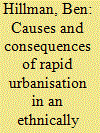

|
|
|
|
|
| Publication |
2013.
|
| Summary/Abstract |
In contrast with China's coastal regions, where rural urbanisation has largely been a result of industrialisation, urbanisation in the once predominantly rural towns of the interior is sometimes driven by local government policies. This article focuses on a case study of Zhongdian (Shangri-la), where urbanisation has mainly been driven by tourism. It shows that while the problem of land seizures has been generally less violent in this sparsely populated area of the interior, the urbanisation of this ethnically diverse area of northern Yunnan has generated a distinct set of problems. While local officials have strong incentives to pursue policies that promote urbanisation, they have few incentives to pursue policies that promote equal access to the new economic opportunities that accompany urbanisation.
|
|
|
|
|
|
|
|
|
|
|
|
|
|
|
|
| 2 |
ID:
122935


|
|
|
|
|
| Publication |
2013.
|
| Summary/Abstract |
By developing and using indexes reflecting "quasi-urban" status, this paper attempts to quantitatively estimate the "invisible" contribution of in situ urbanisation to the overall urbanisation process in the county areas of Fujian Province. The results show that the urbanisation level of the county areas in Fujian Province would be significantly increased if the urban characteristics resulting from in situ urbanisation were fully reflected, suggesting that the conventional urban statistics seriously underestimate the true extent of rural-urban transformation in the county areas. Furthermore, such underestimation is more serious in the coastal areas with most dynamic socioeconomic development, and thus distorts the true picture of the spatial pattern of rural-urban transformation. The paper explores the implications of the above results for the understanding of China's urbanisation process, suggesting that rural-urban transformation and the corresponding planning practice in China should be conceptualised in the context of blurred rural-urban distinction and more important roles for rural areas in the urbanisation process.
|
|
|
|
|
|
|
|
|
|
|
|
|
|
|
|
| 3 |
ID:
122934
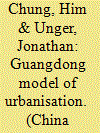

|
|
|
|
|
| Publication |
2013.
|
| Summary/Abstract |
In some parts of China - and especially in Guangdong Province in southern China - rural communities have retained ownership of much of their land when its use is converted into urban neighbourhoods or industrial zones. In these areas, the rural collectives, rather than disappearing, have converted themselves into property companies and have been re-energised and strengthened as rental income pours into their coffers. The native residents, rather than being relocated, usually remain in the village's old residential area. As beneficiaries of the profits generated by their village collective, they have become a new propertied class, often living in middle-class comfort on their dividends and rents. How this operates - and the major economic and social ramifications - is examined through onsite research in four communities: an industrialised village in the Pearl River delta; an urban neighbourhood in Shenzhen with its own subway station, whose land is still owned and administered by rural collectives; and two villages-in-the-city in Guangzhou's new downtown districts, where fancy housing estates and high-rise office blocks owned by village collectives are springing up alongside newly rebuilt village temples and lineage halls.
|
|
|
|
|
|
|
|
|
|
|
|
|
|
|
|
| 4 |
ID:
122932
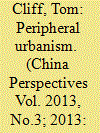

|
|
|
|
|
| Publication |
2013.
|
| Summary/Abstract |
This paper analyses the motives, processes, and effects of urbanisation in Korla, a small but rapidly expanding city in northwest China, where the author conducted over two years of fieldwork. The paper aims to show that the historical monuments of the urban environment are physical manifestations of a stirring, and often violent, program of ideational and socio-economic change that is directed at the periphery and all of its residents - even as some of those residents are also posed as agents of the ongoing transformation.
|
|
|
|
|
|
|
|
|
|
|
|
|
|
|
|
| 5 |
ID:
122936


|
|
|
|
|
| Publication |
2013.
|
| Summary/Abstract |
A major goal of the national program to Build a New Socialist Countryside is to modernise and urbanise the rural built environment. This objective has been bolstered by the extension of state-sponsored urban planning regimes into rural jurisdictions. One of the implications of this is that every administrative village in China is now required to commission and implement a 20-year "master plan" for redevelopment. Through tracing the origins and rationale of key policy initiatives, in the first part of this paper I aim to show how urban planning came to be seen as an appropriate tool for solving a range of intractable rural "problems." In the second part of the paper, I present a case study of village redevelopment in order to illustrate how the principles of urban planning have been applied to the re-making of rural built environments and the transformation of rural life.
|
|
|
|
|
|
|
|
|
|
|
|
|
|
|
|
| 6 |
ID:
122931
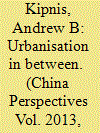

|
|
|
|
|
| Publication |
2013.
|
| Summary/Abstract |
This article focuses on the lived experiences of people who have moved to Zouping, a rapidly urbanising city in Shandong Province. It argues that the variety of their experiences reveals much about Chinese processes of urbanisation. Recent writing on Chinese urbanisation often portrays a sharp social break with rural experience. This article discusses the variable degrees of continuity with rural pasts that different groups of new urbanites experience. It presents Zouping as an intermediate case of Chinese urbanisation, illustrating aspects of both migrant and in situ development, and also argues for the importance of attention to divergent examples of lived experiences, which often blend or transcend the ideal types presented in models of urban experience.
|
|
|
|
|
|
|
|
|
|
|
|
|
|
|
|
| 7 |
ID:
122937
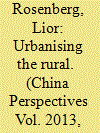

|
|
|
|
|
| Publication |
2013.
|
| Summary/Abstract |
The transition from traditional rural residences to urban-like multi-storey buildings and from traditional villages to rural residential communities (shequ) is one of rural China's most profound developments of the early twenty-first century. Official discourse highlights the potential benefits for villagers, portraying the new residential communities as gateways to modernity and significant steps toward reducing inequality and disparity between the rural and the urban. Based on extensive research in two counties in Shandong and Anhui provinces, this article concludes that while imposing urban-like models of residence may coincide with prosperous communities' circumstances, it may easily become a statist venture of predation and a source of tension and rural discontent in less prosperous communities.
|
|
|
|
|
|
|
|
|
|
|
|
|
|
|
|